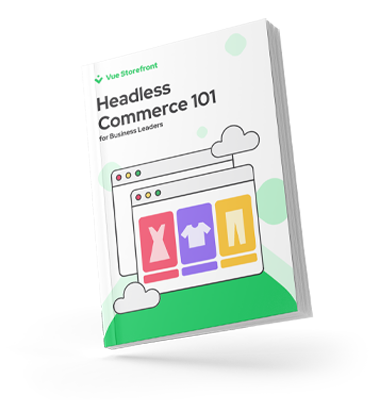14 min
July 31, 2025
What is PWA? Progressive Web Apps in eCommerce - A Short Guide
The so-called Progressive Web App was hailed as the next big thing several years ago. Yet, as often happens with "revolutions" in the tech world, it didn't evolve quite as the initial loud headlines predicted. However, suggesting that PWA has somehow failed is far from the truth.
In fact, companies like Google and Microsoft are part of the PWA movement, and there's no indication they'll abandon it anytime soon.
Read on to find out what PWA is, how it works, and what benefits it can bring to your online store.
Listen to the audio version of this article.
What is PWA?
A Progressive Web Application (PWA) is a type of web application that can function as both a website and a mobile app on any device. It's an excellent solution for poor mobile UX and low conversion rates in your online store. By leveraging standard technologies, a PWA aims to deliver a native user experience, with faster conversion and a cleaner Browse experience even with a poor internet connection.
PWA are written in JavaScript, CSS, and HTML. They look and behave like regular websites (meaning they are searchable in web browsers). However, they provide functionalities identical to those offered by mobile applications: they are fast, can work offline, send push notifications, and utilize user device features.
What's more, PWAs can be placed in popular app marketplaces like the App Store or Google Play.
Since they don't assume any specific implementation, it's not easy to formulate a proper, dictionary-like definition of a PWA. Google, the company that invented them, doesn't offer much help, and their official launch was quite vague.
PWA is:
Reliable - Loads instantly even in uncertain network conditions.
Fast - Responds quickly to user interaction with silky smooth animations and no choppy scrolling.
Engaging - Feels like a naturally installed app on the device, fostering user engagement.
What is PWA's objective?
You've probably heard it before: the world of e-commerce has never changed so fast. It's been a cliché for some time, but today it's even more relevant than ever. Mobile-first e-commerce has been the standard for years, and it's gaining more popularity every day. The numbers speak for themselves:
Global mobile users first eclipsed desktop users in 2014 (comScore).
By 2025, mobile commerce retail sales are projected to reach $728.28 billion, accounting for 44.2% of US e-commerce retail sales (Business Insider).
80% of shoppers used a mobile phone while in a physical store to look up product reviews, compare prices, or find alternative store locations (Outerbox Design).
This means that if your business is not yet at this stage of development, it's definitely high time to set a course for mobile commerce. With PWA, which aims to enable mobile-first e-commerce transformation, you will do it in the most convenient and fastest way, and at the lowest cost.
The birth of PWA

Google is the godfather of PWAs, which should come as no surprise. By blending web-style and mobile UX, it has a chance to break down the walled garden of data guarded by Google and Apple. While Google can afford this (because its data warehouses also contain quite a large part of the world's web), Apple is not in such a comfortable position here.
However, the idea of focusing on the mobile user experience was actually put forward by Steve Jobs over a decade ago. The Apple CEO presented this concept during the iPhone launch in 2007, as it seemed obvious at the beginning of the mobile revolution that external applications would be the way to leverage the popularity of the nascent Apple device. Jobs wanted to encourage developers to create them.
This idea, however, was short-lived. In July 2008, Apple put the concept of "universal applications" on ice. In return, the company introduced the App Store, and mobile apps began to dominate the internet.
The PWA-specific approach had to wait for its moment, which came a decade later. In 2015, Frances Berriman and Alex Russell, the originators of the term PWA, wrote in the foreword to Jason Grigsby's book "Progressive Web Apps": "The idea of native apps always felt like a regression. Walled gardens with horrible search, questionable security, and an endless update tax – it felt like the 90s."
Berriman and Russell noticed a new type of websites delivering a much better user experience than traditional web applications. They named them "Progressive Web Apps." A year later, during the Google I/O conference, Eric Bidelman, a senior developer programs engineer, presented Progressive Web Apps as a new standard in web development.
In early 2018, Apple sent support for core PWA features, but still imposed certain limitations regarding cache capacity or native push notifications.
Progressive Web Apps: Benefits Enabling Mobile-First Commerce
The main benefits of implementing PWA include improved speed and performance, an app-like UX, and cross-platform utilization. However, these are just a few examples from a wide pool of advantages.
1. Short time-to-market, mobile market
Progressive Web Apps are the simplest way to pave the path to the mobile world. That's simply a fact. They are built with the most standard web technologies and can be set up within a few months.
What's more, with PWA, you don't have to create two separate applications for iOS and Android, as they work on all types of devices.
2. All capabilities delivered at once
Instead of building a separate website and a native mobile app, by using PWA technology, your team can build just one application that works seamlessly on any device. With Progressive Web Apps, you simply don't need to create a separate native app. Just adapt your storefront with PWA to have a store that works smoothly as both a website and a native app.
And yes, Progressive Web Apps can provide a consistent app-like experience on every device. Depending on the browser's capabilities, PWAs automatically and progressively enhance their built-in features to look and feel like you're using a native app.
3. Cost-efficiency optimization
As a result of all these PWA capabilities, you not only save time but also lower development costs. Simply put, instead of developing three entities – an iOS app, an Android app, and a website – you can build just one that works well on all these devices.
Furthermore, a PWA doesn't require a presence in the Google Play Store or App Store, which means no fees. However, if you wish to submit your PWA to the App Store or Google Play, it's quite easy with Vue Storefront.
4. Reduced Customer Acquisition Cost (CAC)
PWA allows you to build websites that prompt the user to install the app directly from their mobile browser. This means users don't have to visit an app store and download a native app to use it. This increases the chances that they will want to use it.
Unlike native apps, there's also no need to download updates for PWA. This significantly increases the likelihood of successfully converting users from the website to the native app. In turn, this lowers the customer acquisition cost.
5. PWA makes use of the headless commerce
PWA leverages a headless architecture, which gives your business exceptional agility – both in composing your eCommerce tech stack from the best solutions and in strongly optimizing conversion rates.
With a headless approach, your store's frontend will be separated from the eCommerce platform's backend. This means great freedom for your marketing team – with a headless architecture (like a headless CMS) on board, they become independent from developers and can easily implement changes on their own.
6. Better SEO scores
One of the main advantages of PWA is that they speed up the app's indexing process in Google. They have URLs like standard websites, which means Google is able to crawl and index them.
Additionally, a full Server-Side Rendering (SSR) implementation provides crawlers with complete documents to index – this is particularly important for large eCommerce stores.
Search engines favor smooth, fast applications with limited retention and promote them with a higher ranking in search results. And as we all know, the higher the position, the greater the chance of capturing user attention.
Not to mention, page performance reduces the bounce rate – a metric that also influences how Google assesses a page and determines its position in the SERP (Search Engine Results Page).
7. Reduced Bounce Rate
A DoubleClick study showed that 53% of mobile site visits are abandoned if pages take longer than 3 seconds to load. It was also found that the average mobile page load time on 3G connections is 19 seconds.
PWAs, on the other hand, load instantly regardless of network conditions, even offline. They are truly lightweight because they use placeholders ready to be filled with fetched content, giving users the feeling that the app loads instantaneously.
A PWA works offline, allowing the user to continue Browse even without an internet connection. With any other online store, they would have to abandon the purchase process. With PWA, however, a poor network will no longer reduce your sales.
8. Improved engagement, mobile conversions, and revenue
Comparing mobile and desktop conversions, many merchants experience a mobile gap: customers spend more time Browse on mobile devices, but mobile conversions are still significantly lower than desktop conversions.
Of course, this is partly due to the different goals of mobile users. However, some companies can bridge this gap and significantly increase their mobile revenue. To follow suit, you need a well-functioning website that is mobile-optimized and has great UX.
PWA helps achieve these goals partly due to full-screen capabilities, as well as easy access (thanks to the Add to Home Screen option). Push notifications, previously only available for native apps, further improve user re-engagement.
What is the difference between Progressive Web Apps and Native Mobile Apps?
Native apps reigned supreme for a decade, but we are finally moving towards a unified experience across every platform and device. Progressive Web Apps are mobile-oriented and incredibly lightweight compared to native apps, providing the same level of interactivity.
Although leading players in the online landscape such as Alibaba, Pinterest, and Twitter have already embraced them and implemented PWAs on their sites, the term Progressive Web App remained quite obscure for smaller players for years. Many of them, realizing that a mobile-first approach is a necessity nowadays, are convinced there is no alternative to Responsive Web Design or native apps.
However, awareness of the benefits of this concept is constantly growing, as evidenced by Google's statistics and the increasing number of live Vue Storefront projects.
Let's look at a general comparison of Progressive Web Apps and native applications below.
What are the PWA requirements?
To set up a Progressive Web App, you need to secure a few elements:
Safe connection (HTTPS)
It will be necessary to provide a secure server with an HTTPS connection. This is a way to both protect user data and build an additional layer of security within your website.
Service Workers
The so-called Service worker is a client-side JavaScript file added to your codebase that runs in the background to emulate app-like functionalities.
The PWA Manifest File
You need to generate a simple JSON file (PWA manifest file) that provides the browser with information about the appearance and behavior of your PWA when installed on a user's mobile device.
It includes basic information such as the app's name, icons used, or colors, and aims to enhance the native app-like experience.
Important: The PWA manifest file is required by Google Chrome to display the "Add to Home Screen" prompt.
Check out Examples of Progressive Web Apps
Progressive Web Apps are already here and delivering excellent results. Just take a look!
+300% revenue growth at Best Western Hotels
+100% engagement increase at Forbes.com
+74% increase in time spent on AliExpress
+70% increase in conversion rate at Flipkart
+3X increase in conversion rate at MakeMyTrip.com
+3X increase in ad CTR at Wego
Below you will find more details on some PWA implementations with Vue Storefront.
Foodl

Foodl, an online B2B marketplace for the HoReCa industry, which lacked a human touch in digital services. To fix this, they were looking for a flexible solution that would support the company's growth with the desired UX. The company didn't want to force customers into anything just to, for example, shorten the buyer's journey or use specific devices.
Mindcurv thoroughly analyzed customer and partner experiences, mapped their user journeys, defined potential bottlenecks and needs, and based on this data, designed the UX to match the business processes specific to the HoReCa industry.
As part of a larger transformation and tech stack composition, Foodl with Mindcurv were able to shape with Vue Storefront PWA:
User journeys independent of device and channel
Time-to-market
Future-proof architecture for scaling
Garten-und-Freizeit

Raumschmiede, owner of the Garten-und-Freizeit brand, was looking for a way to secure and accelerate growth. Facing transformation, they sought a solution that would provide an excellent UX while handling complex business logic for over 30,000 different products. In addition, they needed to ensure consistent, individually tailored customer service.
Raumschmiede, together with their partner agency Team23, opted for Vue Storefront for several reasons. One of them was technology. Thanks to the architecture and default PWA features, the partners knew they would achieve their set goals.
PWA as the first choice quickly increased revenue, as well as providing:
fast loading and launch
mobile-first approach
offline mode
SEO and crawler-friendly architecture
platform independence
Which resulted in:
+350% Monthly active users
+630% Monthly organic search traffic
-39% Decrease in bounce rates
An API-first architecture allows merchants to choose the best services in their niches and tailor their eCommerce system to be exactly what they need.
Consistent Customer Experience and Better Customer Engagement
Progressive Web Apps are primarily about user experience, aiming to increase user engagement and all the benefits that come with it. However, you can choose how you leverage the advantages of PWA. Improving page speed is obviously a no-brainer, but there's much more to it.
PWAs, being discoverable in web browsers, can also benefit from the popularity of voice search, which on the surface is another step towards making digital interaction more human and the entire UX more consistent.
Voice search is closely linked to mobile optimization, where website performance plays a key role. This, in turn, makes PWAs the most suitable solutions to support voice search optimization – especially since voice assistants are still most commonly used on smartphones.
PWA allows for accelerating website performance. Moreover, they are a standard supported by Google itself, which automatically makes them an ideal fit for voice solutions.
In the omnichannel era, user experience should be viewed in the big picture, encompassing every touchpoint, both offline and online. If the customer journey is not managed, users may feel overwhelmed and confused, which is not the best foundation for a shopping experience.
Vue Storefront Progressive Web App offers significant business opportunities for eCommerce merchants looking to bridge their mobile gap:
Vue Storefront PWA has a significantly smaller size than native apps, so it loads faster, performs better on low-bandwidth networks, and takes up less space on the user's device.
PWAs synchronize data in the background, even when the user is inactive. The app is always up-to-date with the latest version and content served instantly.
Vue Storefront is fully searchable and indexable, unlike native apps. What's more, the user can easily bookmark and share any page.
PWA provides a responsive and fluid shopping experience, so there's no need to create separate applications for different web browsers and platforms.
Can PWA work offline?
Yes, PWA allows the user to continue Browse the page even without an internet connection. With any other online store, they would typically have to abandon the purchase process. However, with PWA, a poor network will not reduce your sales.
Will PWA replace native apps?
In all likelihood, PWAs will not replace native apps. However, they are a great alternative to costly native applications. They are the fastest and most affordable way to embrace mobile-first commerce. While native apps are limited to specific devices, are expensive to build and maintain – with PWA, you deliver all capabilities at once, in a fraction of the time.
Are Progressive Web Apps worth it?
eCommerce companies observe relatively high mobile traffic on their sites, but it often doesn't translate into high conversion rates. To change this, they need a responsive website with a mobile-friendly UX. The simplest, fastest, and cheapest way to achieve this goal is a Progressive Web App. So yes, it's worth doing.
Source: https://vuestorefront.io/pwa







